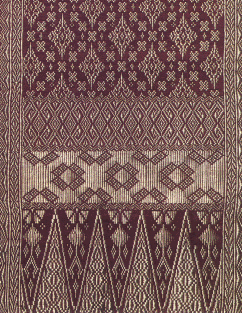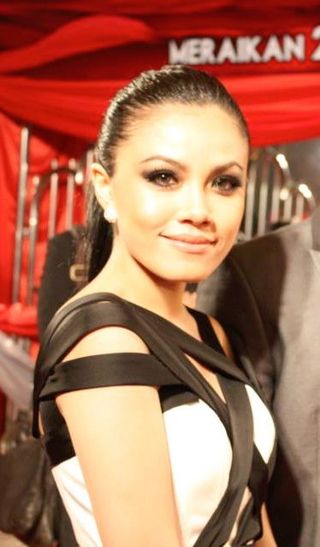
The Ibans or Sea Dayaks are an Austronesian ethnic group indigenous to northwestern Borneo. The Ibans are also known as Sea Dayaks and the title Dayak was given by the British and the Dutch to various ethnic groups in Borneo island.

Dato' Mohamad Nasir bin Mohamed is a Malaysian poet, singer-songwriter, composer, producer, actor and film director also known as a Sifu in the Malaysian music industry.

Songket or sungkit is a tenun fabric that belongs to the brocade family of textiles of Brunei, Indonesia, Malaysia, and Singapore. It is hand-woven in silk or cotton, and intricately patterned with gold or silver threads. The metallic threads stand out against the background cloth to create a shimmering effect. In the weaving process the metallic threads are inserted in between the silk or cotton weft (latitudinal) threads in a technique called supplementary weft weaving technique.

Erra Fazira, is a Malaysian actress, singer, fashion model, tv host, producer and beauty pageant titleholder who was crowned Miss Malaysia World 1992.

The National Film Department of Malaysia, abbreviated FNM, sometimes Jabatan Filem Negara (JFN) or informally the Malaysian Film Unit; was a Malaysian state-owned film organization. It is the country's first film studio and the government department under the Malaysian Ministry of Communications and Multimedia, which was responsible for the filming and documentation of national events as well as producing factual and unscripted contents. In its heyday, FNM became the country's most prominent film agency. Its corporate emblem features a jumping Malayan tiger, which was synonymous with the agency and its headquarters were located in Petaling Jaya, Selangor.

Prasasti Seni is the eleventh studio album from Malaysian pop singer-songwriter Siti Nurhaliza. The album was released on 12 April 2004 in Malaysia, Singapore and Brunei and at a later time in Indonesia on 23 May 2004. This album also includes a heart-shaped VCD that features a video message from Siti and a video clip of "Pejam Matamu". Notable singles include "Dialah Di Hati", which is also nominated in Best Song category in Anugerah Industri Muzik, "Lagu Rindu" & "Seindah Biasa".
Liyana binti Jasmay is a Malaysian actress, singer, producer and director.
Dato' Masir anak Kujat is a Malaysian politician of Iban descent. He has served as Member of Parliament (MP) for Sri Aman from March 2008 until November 2022.

Shaheizy Sam bin Abdul Samad is a Malaysian actor who was known as a young star in the 1990s before rising to fame in the film Bohsia: Jangan Pilih Jalan Hitam in 2009, and Adnan Sempit in the following year.

The Fort Sylvia is a historical fort in Kapit, Sarawak, Malaysia. Built in 1880, it was renamed after Rani Sylvia Brooke, wife of Rajah Charles Vyner Brooke, in 1925. During the 1960s, the fort housed the District Office and the District Court House, and later the Resident's Office when Kapit Division was formed in 1973.

Siti Zaqyah Abdul Razak, known professionally as Tiz Zaqyah, is a Malaysian actress, model and singer. She debuted in 2006 and since then has starred in films, dramas, telemovies and television and magazine advertisements. She rose to fame for playing the role of Nur Amina in the 2009 hit drama Nur Kasih with Remy Ishak, Fizz Fairuz and Sharifah Sofia. She became best known for her leading roles in Asmaradana, Gemilang, Soffiya, Dejavu di Kinabalu, Sebenarnya, Saya Isteri Dia! where she played a role of Shaf alongside Izzue Islam, Cinta Jangan Pergi where she acted with her acclaimed former counterpart partner, Remy Ishak, Jodoh Itu Milik Kita and Kusinero Cinta.

Unplugged is a live album by Malaysian recording artist Siti Nurhaliza. It was released in multiple formats, both physical and digital in Malaysia on 30 June 2015. The main live tracks were all taken from her 2015 unplugged concert at Istana Budaya on 7 April 2015. The CD, digital download and LP record versions of the album however come with three new bonus songs, "Menatap dalam Mimpi", "Engkau" ("You") and "Mikraj Cinta". All were recorded specifically to accompany the three audio releases.

Ngajat is popular family of dances among the Iban people in Sarawak, Malaysia. It's also popular in Brunei and West Kalimantan, Indonesia. In 2007, Ngajat was recognized as Intangible Cultural Heritage in Malaysia by Minister of Culture, Arts and Heritage.

Mohammad Zalimei bin Ishak, better known by his stage name as Remy Ishak is a Malaysian actor who was born in Melaka. He was first introduced to the film industry by independent director Osman Ali in 2006. He gained fame for his performance in Nur Kasih directed by Kabir Bhatia, which aired on TV3 in 2009. He later starred in the 2018 film Pulang.
Mohd Shukri bin Yahaya is a Malaysian actor and director. Starting his acting career in 2011 after his talent was discovered by renowned film director Osman Ali through the film Jiwa Taiko. Since then, he has appeared in leading roles in many successful and high-rated television series including Asam Pedas Untuk Dia (2015), 7 Hari Mencintaiku (2016), Andainya Takdir (2017), Andainya Takdir 2 (2018), Kerana Dia Manusia Biasa (2019), 7 Hari Mencintaiku 2 (2020), Rindu Awak Separuh Nyawa (2021) and Andai Itu Takdirnya (2023). Throughout his career, he has won several awards for his roles in the television series 7 Hari Mencintaiku, Andainya Takdir and Split TV Series.

Dato' Mizal Zaini, known professionally as AC Mizal, is a Malaysian actor, singer, comedian, TV host and former radio presenter.
The Ibans or Sea Dayaks are a branch of the Dayak people on the island of Borneo in Southeast Asia. It is believed that the term "Iban" was originally from the Kayan Language. "Iban" or "Hivan" means human or person.
Nurul Jannah Muner, known professionally as Janna Nick, is a Malaysian actress, singer, host, director and producer. Starting her career in entertainment, she is known for her roles in television films such as Syurga Nur, Kau Aku Kita, Suami Tanpa Cinta and My Coffee Prince. She began her feature film debut with Kimchi Untuk Awak (2017).
Kanang anak Langkau: The Iban Warrior is a 2017 Malaysian Malay-language biographical historical drama film directed by Bade Hj. Azmi with the script co-written by Zainal Fikri and Asmira Suhadis, detailing the life and career of a soldier, Kanang anak Langkau. The film starring Kanang's son, Langgi anak Kanang, who played the character of his father, along with Adi Putra, Johan As'ari, Livonia Ricky Guing, Jimmy Leong, Adam Shah, Aidil Aziz, Ruzana Ibrahim and Zachery Francis. The movie aired on 16 March 2017.

Tenun is an artful Indonesian technique of making a fabric by weaving different colours of threads. Tenun belongs to one of the typical Indonesian cultural arts produced by hand skills using traditional looms. The word Tenun itself has a high meaning, historical value, and technique in terms of colors, motifs, and types of materials and threads used and each region has its own characteristics. In addition, Tenun is also one of Indonesia's original cultural heritages that is still maintained and preserved to this day.















